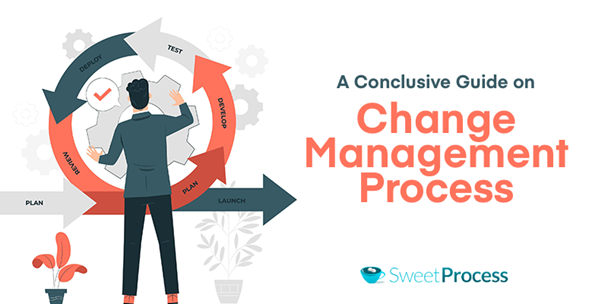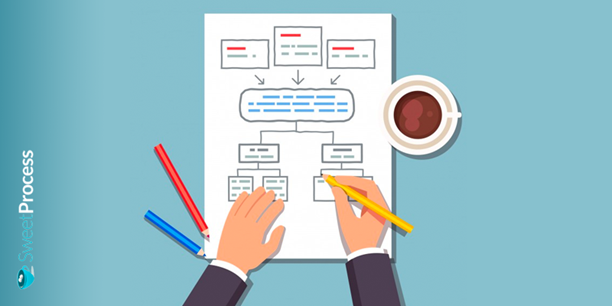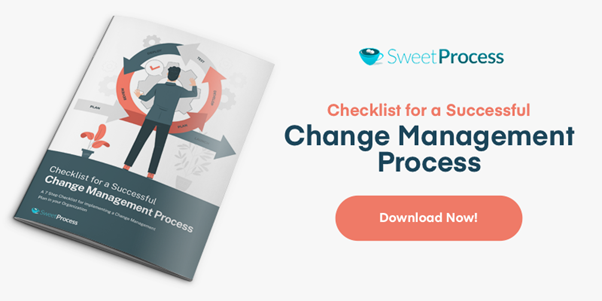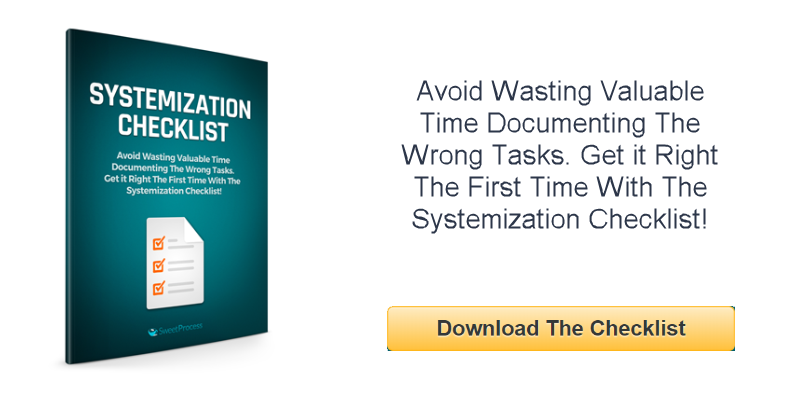Easy Step by Step Guide to Managing Change
Change Management Process: A Conclusive Guide

Featured Bonus Content: Download the FREE Change Management Process Checklist! Click Here To Download It.
The uncertainty of new territory is frightening for many people. Not knowing the outcome of change prevents many organizations from reaching their full potential. Obsolete processes linger for too long at the expense of growth. Video-rental giant Blockbuster paid the price for not adapting to change. It went from being valued at $3 billion in one year to filing for bankruptcy in 2010—losing to its competitor Netflix which was in tune with its environment.
Would you rather stick to a system that is not working or implement one that works? A lack of knowledge in executing change hinders organizations from going through with it. Change management streamlines the change process for success. Read along to learn all you need to know about the change management process and how you can execute it to attain success in your company.
Change Management Process Guide – Content Index
Chapter 1: What is Change Management?
Chapter 2: Why You Need an Effective Change Management Process in Your Organization
Chapter 3: Different Types of Change Management
Chapter 4: Nine Critical Steps in the Change Management Process
Chapter 5: The Implications of Managing Change Badly
Chapter 6: Common Challenges of Organizational Change Management
Chapter 7: How to Choose an Effective Change Management Tool
Chapter 8: Why SweetProcess is the Right Change Management Tool for Your Organization
Chapter 9: Change Management Models
Chapter 1: What is Change Management?

The change management process is a series of tasks outlined for a seamless transition from a current state of affairs to a new one without obstructing the workflow or suffering any damages.
The business terrain is continually evolving. An organization that fails to adapt to rising needs becomes obsolete and loses out in the long run. Take the mobile phone brand Blackberry for instance. The one-time smartphone favorite, which had over 80 million users worldwide, recorded a 0.2% market share in 2016 due to its failure to adopt touchscreen technology. Change is a necessity for business survival.
Many organizations are not oblivious of the need for change but lack the knowledge to implement it effectively. Things may slip through the cracks in the process, causing damages that are sometimes irreparable.
Organizational change management is a step-by-step measure designed by an organization to ensure that adjustments made in critical areas are effectively managed without jeopardizing operations. Some include work ethic, company culture, business procedures, internal processes, operations, corporate hierarchy, etc.
How can change management impact your organization? In the next chapter, we shall outline why you need a good change management process and your employees' role in it.
Chapter 2: Why You Need an Effective Change Management Process in Your Organization

A good change management process ensures the following in your organization:
- Prevention of accidents
- Increase in asset reliability
- Traceability of changes
- Evaluation of alternative
Change management is about managing people. Think about it: who will carry out the new procedures? Your employees' acceptance or rejection of the project will influence its outcomes.
A shift from the norm sometimes evokes unfavorable reactions from people. Most employees would rather do things the way they have always done them than try out a new approach due to fear of the unknown. The most efficient employees are motivated by effective procedures. It is your responsibility to help them overcome that fear by managing the transition effectively. Make everyone a part of the change management process.
Successful change management begins with carrying each person in the organization along. Individual contributions in the workplace make or mar the entire workflow. There is a ripple effect across the organization if one person drops the ball.
A top-down approach of single-handedly making changes in an organization and imposing the new order on employees is counterproductive. Employees may not outright object to the change, but they may be reluctant to drive it.
People find it difficult to buy into what they do not understand. Communicate the "why" behind the change to each employee so that they will understand it. Once employees are sold on the need for the change, they become fully involved in all its related activities, willingly without being mandated to.
Change is managed in different categories. Read on to the next chapter to know the different types of change management levels and how to handle them.
Chapter 3: Different Types of Change Management
Change occurs at different levels and requires different management approaches to be successful. There are three basic change management categories, namely individual change management, organizational change management, and enterprise change management.
Individual Change Management
Individual change management speaks to the people in the changing environment. Understanding the people you are dealing with is key in managing them effectively. Devise a psychological approach to pander to the emotions of your employees on an individual level.
Organizational Change Management
Organizational change management is an extension of individual change management. Having addressed your employees' psychological needs to help them buy into your change plan, you now need to address core workplace issues.
Are there existing procedures or practices in your organization that may obstruct the change you are setting up? Resolve the issues to prevent any obstructions in the way. Equip your employees with the necessary skills to perform the new tasks successfully.
Enterprise Change Management
Enterprise change management addresses every area of the entire organization from top-down, including leadership and management roles, structures, processes, procedures, etc.
The different departments in your organization may function individually, but they are intertwined. A problem in one department affects the entire organization in the long run. Ensure that your organization's various areas are part of the change process and tied into onefold to make your organization nimbler.
The bone of contention for many organizations is how to execute change. In the next chapter, we shall discuss the critical steps in the change management process.
Chapter 4: Nine Critical Steps in the Change Management Process

There is no one-size-fits-all approach to change management. The factors leading to change may differ among organizations, but the core principles of change management are the same. The following steps will guide you in meeting the unique needs of your organization:
1. Define your objective(s)
The first step in the change management process is to define what you want to achieve in the end. Having a crystal-clear objective requires an understanding of where your organization currently lies and where you want it to be.
Your change management process is dead on arrival if your objective contradicts your company's vision. Your organization may evolve but staying true to its vision will help you retain your identity and originality.
2. Get your management team to buy-in
Single-handedly diving into the change management process is a no-no. You cannot implement change all by yourself, even with all the knowledge and technical know-how. You need the support of your management team to set the ball rolling.
Start by presenting the problems that the change you seek will solve in your organization. By doing this, you make it about the organization and not yourself.
3. Appoint your change management process champions
Although everyone's support in your organization is invaluable, you need some key players that will lead the change management process in different areas. Think of them as your managers—they will help you coordinate activities at micro-levels. Have a heart-to-heart discussion with your change champions about the project and outline their responsibilities.
4. Communicate your vision to the entire team
The next step is to get everyone in your organization to buy-in. Mandating everyone to buy into the change plan simply because you are the boss is not the best approach. You will get the best results when they buy-in because they share your vision.
Share your vision passionately. Be open to contributions as team members might have valuable input that you did not think of earlier.
5. Get rid of roadblocks
Now that you have gotten everyone on the same page as you, you need to ensure that there are no roadblocks in your way; otherwise, your team will not function optimally.
- What old procedures or systems need to make way for new ones?
- Do you need to acquire new tools to execute the system you are putting in place?
- Do your team members need to be trained on new skills to perform tasks in the new system?
- Do you need to reassign responsibilities and duties to team members?
6. Break your goal into milestones
If your change goal is big, achieving it all at once may seem impossible. Save yourself the trouble of feeling discouraged by setting small milestones. You and your team will get a sense of accomplishment for your successes at the milestones.
Milestones also help with accountability.
7. Gun for early wins
Nothing gets people pumped up more than early wins; employees are encouraged to work harder, seeing that their efforts are paying off. The reverse is the case when their early efforts look like a waste of time.
Be intentional about early wins by setting targets that are more achievable than others. Engage with team members who play vital roles in achieving those targets to get their maximum inputs.
8. Track your progress
Change management involves a lot of planning, coordinating, controlling, and evaluating. These factors have to be in sync to achieve your objective.
Keep track of how things are unfolding. Are you taking too long to achieve your milestones? If that is the case, what is causing the delay? Are there still roadblocks in your organization?
There is a tendency for your zeal and your team members' to wear off after a few weeks or months. Hold regular meetings with your team to keep them motivated.
9. Improve continuously
Change is a continuous process. Do not become complacent after you have achieved your objective. Review your current business processes continuously for improvement. By doing this, you will identify roadblocks that may arise from the new system you implemented.
Incorporate the change you have achieved in your organizational culture for uniformity and consistency across the entire organization.
What happens when change is poorly managed? Find out in the next chapter.
Chapter 5: The Implications of Managing Change Badly

Failure to successfully implement each step of the change management process leads to the following setbacks:
- A decline in productivity output
- The reluctance of managers or change champions to be fully committed to the change management process
- Loss of motivation among team members to give their best inputs
- The exit of high-performing employees from your company due to a lack of understanding of your vision
- A division between employees and the administration
The change management process is not without hiccups. Read on to the next chapter to find out the common challenges of change management and how to overcome them.
Chapter 6: Common Challenges of Organizational Change Management

Organizational change may be an organization's deliberate effort to improve operations or a response to an unforeseen situation. Whatever the case may be, change management presents a series of challenges. Understanding the roadblocks ahead of time enables you to manage them effectively.
The most common change management challenges include the following:
Managing multiple teams
The need to create multiple teams in the change management process may arise to execute different tasks in different areas. However, carrying everyone along may be a challenge with many distractions at hand. Some team members may be privy to tribal knowledge, while others are oblivious to certain information.
Create standard operating procedures (SOPs) and use effective change management software to keep everyone in the loop and manage tasks.
Managing rising changes in multiple areas
A development in one area of your business could affect other areas, leading to multiple issues to be resolved. If you are not careful, you might end up going in circles.
Your change management process must be thorough and consistent across the entire organization to avoid creating lapses in various areas. Doing this effectively requires using an all-inclusive workflow system that gives everyone involved in the change process access to project reports, ongoing tasks, and communications.
Communication breakdown
The change management process calls for constant communication and an update of business procedures in your organization. Information needs to be communicated across to the team instantly, and updated documents have to be accessible by all parties involved to avoid information imbalance.
Adopt a workflow tool with easy-to-use business process documentation features that allow you to document each procedure clearly and communicate with your team.
Employee resistance
Your employees may not be receptive to the change implementation, and it is nothing personal. Humans are naturally reluctant to accept change. Change readiness consists of six phases: indifference, rejection, doubt, neutrality, experimentation, and commitment. Evaluate the employee readiness level and give them time to process each stage accordingly.
Correcting faulty change systems
Following recommended guidelines to the tee is a prerequisite for effective change management, but sometimes the result might fall short of your expectations. Can you reverse the new system you have implemented? Retracing your footsteps is daunting without a well-planned change management strategy and a tool that keeps your work organized.
Obtaining speedy approvals
Your new systems need to be checked and certified by relevant parties before use. The assessment may be done by either internal or external personnel depending on the nature of your organization.
Automating the approval process is the fastest way to keep your business operations ongoing. An effective workflow system can notify personnel about pending approvals and remind them continuously until the approvals are done.
Your choice of tool for the change management process could genuinely determine how effective your efforts are. Find out how to choose the right change management tool in the next chapter.
Chapter 7: How to Choose an Effective Change Management Tool

Adopting the right change management tool is a watershed moment in your change management process. An effective tool simplifies the task and helps you to achieve your objectives better and faster.
The following factors will guide you in trimming down your list from the numerous change management tools on the market:
Easy setup
Getting the hang of a new system is hard enough, let alone using a complex system. Cut to the chase by getting a cloud-based tool that allows you to dive into it without worrying about complex installations.
Competitive pricing
As much as you want to have the right system, you do not want to exhaust your budget on a single item. Go for a cost-effective change management software with competitive pricing. The charges should be based on the number of users.
No coding
Still, on the subject of ease, a workflow software that requires coding is not a good fit for employees who do not have advanced information technology (IT) skills. Choose one that has a drag-and-drop workflow designer with basic IT knowledge and training.
Web-based integrations
A change management software is most effective when used along with other workflow tools. You will move faster when you and your team can access most (if not all) of the tools you need for the change management process in one place instead of using isolated tools.
Are you having a hard time finding the right change management tool? We have handpicked a perfect tool for you, and we have evidence to back it up. Check it out in the next chapter.
Chapter 8: Why SweetProcess is the Right Change Management Tool for Your Organization
SweetProcess has established itself as a leading SAAS company by helping organizations simplify their most complex business processes, including documenting procedures, implementing policies, empowering employees, managing tasks, etc.
Like many organizations that have used SweetProcess, Mudd Advertising recorded huge success by streamlining its operations with SweetProcess.
Let us take a look at how SweetProcess can enhance your change management process.
Effective business process documentation
Documentation is a huge part of the change management process. The choice of system for documentation makes a big difference. SweetProcess offers the flexibility to write your procedures however you like. Its simplicity allows the entire team to be part of the documentation process. If there are any errors in your documentation, anyone in your team can easily spot them and draw your attention to them. Besides texts, you can use visuals such as diagrams and charts to show the procedures in action.
When Atlantic Sapphire, a salmon farming company headquartered in Denmark, opened a new facility in South Florida, it maintained quality control by transferring its existing operational knowledge by using SweetProcess to document its processes.
Decentralized knowledge base
The success of the change you seek in your organization is not solely dependent on what you know but on what everyone on your team knows. You need to create a leveled field of information among employees, and doing this is a challenge without a decentralized knowledge base. A cloud-based software, SweetProcess is a decentralized knowledge base with remote access. Information that your team members need to execute tasks is just a click away. Everyone gets updated information at the same time as they all use the same documents.
President of Location Accès Crédit, Michel Coutu, was able to enhance his employees' efficiency by creating a solid knowledge base with SweetProcess.
Enhanced employee training
Team members may need some training to operate in the new system you are implementing. Time is of the essence in the change management process. You can speed up your employees' training by creating SOPs for each task in SweetProcess and grant your team members access to the documents. Team members can read up on all they need to know and can always go back to the documents whenever the need arises.
President of Marc Nelson Oil Products, Peter Nelson, overcame the fear of losing valuable employees by using SweetProcess to empower his workers with all they need to know on the job.
Multiple integrations
A single tool cannot meet the various needs of a successful change management process. A combination of several tools makes it all seamless and effective. SweetProcess is optimized for integration with over 1,000 applications. You can set up the integration with the SweetProcess API or Zapier.
Workflow management and tracking
Although team members play different roles in the change management process, everyone needs to move at the same pace for success. SweetProcess allows you to assign tasks to team members and track their progress. Every step completed is checked off and they move on to the next. You get to know when team members are underperforming and hold them accountable.
CEO of Operoo, Troy Westley, breathed a sigh of relief as he was able to streamline his business operations by delegating tasks among his employees and automating their workflow with SweetProcess.
Do you want to enjoy these benefits and more in your organization? Sign up for a 14-day free trial of SweetProcess. Credit card details are not required for the trial: simply sign up and use the tool. If you like it, you can choose to subscribe to it later. You can visit the SweetProcess homepage to learn more about the software and pricing plans.
There are various change management models. We shall explain each model and its procedures in the next chapter.
Chapter 9: Change Management Models
There are different types of change management models to ease the difficulty in implementing change in an organization. Do you want to know the best change management model for your business? The answer to that question is subject to the structure of your organization. Check out the five most common change management models to find the best option for your company.
ADKAR Change Management Model
The ADKAR model focuses on employees' welfare during the change management process. It helps you keep your team members ready and in tune with the process in the following ways:
- Awareness: Inform them about the need for the change.
- Desire: Make them interested and involved in the change process.
- Knowledge: Educate them on what they need to do to achieve the change.
- Ability: Equip them with the necessary skills to operate in the new work environment.
- Reinforcement: Create a conducive environment for the new system to be sustainable.
Lewin's Change Management Model
Lewin's model emphasizes creating an enabling organizational structure for change. It involves three stages, namely:
- Unfreeze: The unfreezing stage is like a block of ice. To get a block of ice into another form, you need to melt it first. Similarly, you need to deconstruct the old ways of doing things in your organization to make way for the new ways by communicating the need for the change effectively.
- Change: Having broken down the walls in the first stage, you need to start implementing the change. Employees will encounter several challenges in the implementation stage. Give them all the support, tools, and resources they need to get by.
- Freeze: Having created a new system for your organization, you need to cement it and make it the standard across the company.
Kotter's Change Management Model
Kotter's model offers a detailed approach to change management, focusing on how employees respond to change. It includes the followings steps:
- Increase urgency: Make employees feel like your organization is lagging already in the absence of the desired change.
- Build the team: Select key individuals with the necessary skills and personalities to help you drive the change.
- Form strategic vision and initiatives: Map out your strategy following employees' skills, abilities, and specializations for maximum results.
- Communicate: Create open communication channels for all parties to interact and contribute to the change process freely.
- Enable action: Remove all roadblocks on the way to allow smooth implementation.
- Focus on short-term goals: Set small goals instead of focusing on the final result from the onset.
- Reinforce change: Make the new system part of your company culture.
- Do not give up: The results you desire may not become visible quickly. Give it time. Be persistent.
McKinsey 7-S Change Management Model
The McKinsey 7-S model takes a look at an organization's design for change management with seven crucial stages that should be taken into consideration.
- Strategy: Create a step-by-step plan for the change management process.
- Structure: Ensure that your plan aligns with the structure of your organization.
- Systems: Equip employees with the needed tools to execute tasks in the change management process.
- Shared values: Share your change values and goals with employees to get them to buy into your vision.
- Style: Cultivate a particular work ethic or approach to create uniformity in operations across your organization.
- Staff: Build the right team to drive the change you are implementing.
- Skills: Conduct training for staff to empower them with the right skills needed to execute tasks in the new system.
Kübler-Ross Five Stage Change Management Model
The Kübler-Ross Five Stage model focuses on employees in the change management process and helps employers understand their employees better. The five stages include:
- Denial: Employees are not ready to accept the change because it is different from what they are used to.
- Anger: Employees' denial metamorphoses into anger when they realize that you are going through with the change.
- Bargaining: Employees engage with you to figure out how to deal with the situation to avoid damaging outcomes.
- Depression: When all efforts made by employees to prevent the change fails, they become depressed. Your workers may exhibit a lack of commitment, lack of excitement, low energy, and zeal.
- Acceptance: Employees will eventually realize that the change is here to stay and that it is in their best interest to adapt to it. At this stage, they will gradually begin to warm up to it and participate in the process.
Conclusion
Recognizing the need for change and implementing it at the right time is vital for business growth and sustenance. Failure to adapt to your rising business needs could be your undoing as you lose to the competition. Change may be challenging, but an effective change management process makes it more accessible.
Download our free Checklist for a Successful Change Management Process to evaluate your performance in your change management journey.

Get Your Free Systemization Checklist

5 Essential Steps To Getting a Task Out of Your Head and Into a System So You Can Scale and Grow Your Business!

Source: https://www.sweetprocess.com/change-management-process/